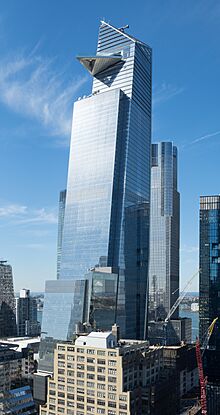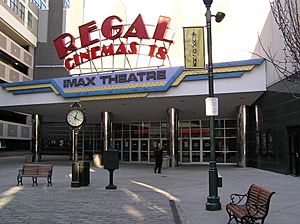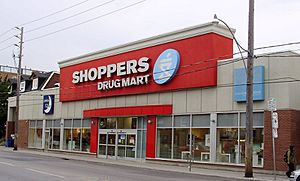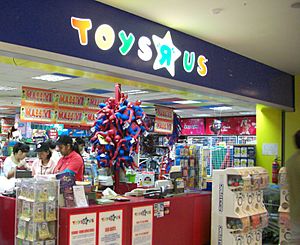Kohlberg Kravis Roberts facts for kids
 |
|

Headquarters at 30 Hudson Yards
|
|
| Public | |
| Traded as |
|
| Industry | Financial services: Private equity (1976–present) Investment banking (2004–present) |
| Founded | 1976 (as Kohlberg Kravis Roberts & Co.) |
| Founders |
|
| Headquarters | 30 Hudson Yards New York City, U.S. |
|
Number of locations
|
20 offices in 16 countries (2010) |
|
Area served
|
Worldwide |
|
Key people
|
Henry R. Kravis (Co-Executive chairman) George R. Roberts (Co-Executive chairman) Joseph Bae (Co-CEO) Scott Nuttall (Co-CEO) |
| Products |
|
| Revenue | |
| AUM | |
| Total assets | |
| Total equity | |
|
Number of employees
|
4,490 (2023) |
KKR & Co. Inc., also known as Kohlberg Kravis Roberts & Co., is a big American company. It helps manage money for other people and businesses. KKR invests in many different types of companies and projects. This includes things like private businesses, energy, buildings, and even credit.
As of 2023, KKR had invested in over 730 private companies. They managed about $553 billion for their clients.
The company was started in 1976. The founders were Jerome Kohlberg Jr., Henry Kravis, and George R. Roberts. They had all worked together before at a company called Bear Stearns. There, they learned about a special way to buy companies called "leveraged buyouts."
KKR has made some very big deals. One famous deal was buying RJR Nabisco in 1989. At the time, it was the largest buyout ever. Another huge deal was buying TXU in 2007, which is still the biggest buyout to this day.
In 2009, KKR started selling shares of its company on the stock market. This allowed more people to own a small part of KKR. In 2010, KKR officially listed its shares on the New York Stock Exchange (NYSE).
About KKR
As of December 2023, KKR had 4,490 employees. Their main office is in 30 Hudson Yards, New York City. KKR also has offices in many other cities around the world. These include London, Tokyo, Singapore, and Dubai.
Who Leads KKR?
- Chairmen: Henry Kravis and George Roberts have been chairmen since 1987.
- Chief Executives: Scott Nuttall and Joseph Bae became co-CEOs in 2021.
Past Leaders
- Jerome Kohlberg Jr. was a co-chairman from 1976 to 1987.
- Henry Kravis, George Roberts, and Jerome Kohlberg Jr. were co-CEOs from 1976 to 1987.
- Henry Kravis and George Roberts were co-CEOs from 1987 to 2021.
How KKR Works
Henry Kravis, one of the founders, once explained that KKR works in three main areas:
- Private Markets: This means investing in companies that are not listed on a stock exchange.
- Public Markets: This involves investing in companies that are listed on stock exchanges.
- Capital Markets: This is about helping companies raise money.
History of KKR
Starting Out
Before KKR, Jerome Kohlberg, Henry Kravis, and George Roberts worked at a company called Bear Stearns. They focused on "bootstrap" investments. This meant buying family-owned businesses that needed new owners. These businesses were often too small to sell shares to the public.

In 1964, a deal involving Orkin Exterminating Company was one of the first big "leveraged buyouts." In a leveraged buyout, a company is bought mostly with borrowed money. The three bankers did more of these deals.
By 1976, they decided to leave Bear Stearns and start their own company. They called it Kohlberg Kravis Roberts & Co., or KKR for short. Their first buyout as KKR was A.J. Industries in 1976.
KKR started raising money from big investors like banks and pension funds. A pension fund from Oregon State was one of their first large investors. They still invest with KKR today.
In 1979, KKR bought Houdaille Industries for $380 million. This was a very risky deal at the time. The company later broke up, and many jobs were lost.
Here are some of KKR's big deals in the 1980s:
| Investment | Year Acquired | What happened |
|---|---|---|
| Malone & Hyde | 1984 | KKR bought this food company and supermarket operator. |
| Wometco Enterprises | 1984 | KKR bought this entertainment company for over $1 billion. It was the first billion-dollar buyout. |
| Beatrice Companies | 1985 | KKR led the $6.1 billion buyout of Beatrice. This company owned brands like Samsonite and Tropicana. It was the largest buyout at that time. |
| Safeway | 1986 | KKR bought Safeway for $5.5 billion. They helped the company avoid a hostile takeover. Safeway became a public company again in 1990. |
| Jim Walter Corp. (later Walter Industries) |
1987 | KKR bought this company for $3.3 billion. But the company faced big lawsuits, and the KKR holding company went bankrupt in 1989. |
Buying RJR Nabisco
RJR Nabisco In 1987, Jerome Kohlberg left KKR. Henry Kravis became the main leader. Under Kravis and Roberts, KKR made its most famous deal: the 1988 buyout of RJR Nabisco. This was a huge company that made food and tobacco products.
The RJR Nabisco buyout cost $25 billion. It was the largest buyout in history for 17 years. This deal was so famous that a book and a TV movie were made about it, called Barbarians at the Gate.
The CEO of RJR Nabisco, F. Ross Johnson, first tried to buy the company himself. KKR then made a higher offer. There was a big competition between Johnson's group and KKR. KKR's offer was finally accepted by the RJR board. Johnson received $53 million from the deal. KKR earned a $75 million fee.
This deal was very big. Even though other buyouts have been larger since, none have been bigger when you adjust for inflation.
After RJR Nabisco (Early 1990s)
After buying RJR Nabisco in 1989, KKR spent the early 1990s trying to pay off the company's huge debt. They sold off parts of RJR and changed how the company was set up. KKR didn't make any new investments in 1990.
KKR put more money into RJR in 1990 to help its finances. They also sold shares of RJR to the public again. By 1995, KKR no longer owned any part of RJR Nabisco. KKR finally made a profit from this investment in 2004, after many years.
Investments in the Early 1990s
Because it was harder to borrow money, KKR changed its strategy. They started buying many smaller companies in the same industry. Then they would combine them into one bigger company. This was called a "leveraged buildup."
One big investment was Primedia, a media company. KKR bought many different media businesses and combined them. KKR kept investing in Primedia for many years. However, KKR lost money on its investment in Primedia's stock.
KKR also invested in other companies during this time:
- They partnered with Fleet/Norstar Financial Group to buy Bank of New England in 1991.
- They bought American Re Corporation from Aetna in 1992.
- They bought a part of TW Corporation, which owned Denny's, in 1992.
- Other investments included World Color Press, RELTEC Corporation, and Bruno's.
1996–1999: More Deals
By the mid-1990s, it was easier to borrow money again. KKR raised a new fund of $6 billion, which was a record at the time. KKR also agreed to charge lower fees to its investors.

KKR made many investments in the late 1990s:
- Spalding Holdings Corporation and Evenflo (1996)
- Newsquest (1996)
- KinderCare Learning Centers (1997)
- Amphenol Corporation (1997)
- Randalls Food Markets (1997)
- Willis Group Holdings (1998)
- Smiths Group (1999)
- Wincor Nixdorf (1999)
One of KKR's biggest investments in the 1990s was Regal Cinemas in 1998. KKR wanted to combine Regal with other movie theater companies. But the deal fell apart. Two years later, Regal went bankrupt.
2000–2005: New Century, New Deals
At the start of the 2000s, some other big investment firms struggled. KKR had some losses, like with Regal Cinemas. But they also had successes, like with Willis Group and Wincor Nixdorf.

KKR was one of the few firms that could still do large buyouts after the "dot-com bubble" burst. They bought:
- Shoppers Drug Mart, a Canadian pharmacy chain. KKR later sold its investment in 2002.
- Bell Canada Yellow Pages. This company was made public in 2004.

In 2004, KKR joined with other companies to buy Toys "R" Us, the toy store, for $6.6 billion. This was one of the biggest buyouts in several years.
In 2005, KKR was part of a group of seven firms that bought SunGard for $11.3 billion. This was the largest leveraged buyout since RJR Nabisco. It was also the biggest buyout of a technology company at that time. Many firms working together on one deal like this is called a "club deal."
Big Buyouts in 2006–2007
In 2006, KKR raised a new fund of $17.6 billion. They used this money to make some of the largest buyouts ever.
KKR's $44 billion takeover of TXU, a power company in Texas, in 2007 was the biggest leveraged buyout of that time. It is still the largest buyout ever completed.
Here are some other major companies KKR bought in 2006 and 2007:
| Investment | Year | What happened |
|---|---|---|
| HCA | 2006 | KKR and other firms bought this hospital company for $31.6 billion. This deal was bigger than the RJR Nabisco buyout. |
| NXP Semiconductors | 2006 | KKR and other partners bought most of Philips' semiconductor business for €6.4 billion. The new company was named NXP Semiconductors. |
| TDC A/S | 2006 | KKR and other firms bought this Danish phone company for €12.2 billion. It was one of the largest European buyouts. |
| Dollar General | 2007 | KKR bought this chain of discount stores in the U.S. |
| Alliance Boots | 2007 | KKR bought this UK drug store retailer for £12.4 billion. |
| Biomet | 2007 | KKR and other firms bought this medical devices company for $11.6 billion. |
| First Data | 2007 | KKR bought this credit card payment processor for $29 billion. |
| TXU (Energy Future Holdings) | 2007 | KKR led a group that bought this power company for $44.37 billion. This is the largest buyout in history. The deal also changed how the company handled its environmental impact. |
KKR also made other investments during this time, like in Legg Mason, Sun Microsystems, and Seven Network.
KKR was also involved in a failed buyout of Harman International Industries, an audio equipment maker. KKR and Goldman Sachs pulled out of the $8 billion deal in 2007.
Going Public in 2007
In 2007, KKR tried to sell shares of its own management company to the public. This would let investors own a part of KKR itself. But the financial crisis made it hard to get a good price, so they put off the plan.
In 2008, KKR announced a new plan to list its shares. In October 2009, KKR listed shares on the Euronext exchange. Then, in July 2010, they listed on the New York Stock Exchange. This public listing represented about 30% of KKR.
2010–2019: More Growth
In 2011, KKR led a group that bought Samson Investment Company for about $7.2 billion. However, the company later went bankrupt in 2015 because oil and gas prices dropped.
In 2012, KKR made its first investment in retail real estate, buying Yorktown Center in Illinois.
In 2013, KKR sold its share in the music company BMG Rights Management.
In 2014, KKR bought Sedgwick Claims Management Services Inc for $2.4 billion. They also invested in a Spanish energy business, Fujian Sunner Development (China's largest chicken farmer), and Savant Systems (a lighting firm). KKR also combined two landscaping companies, ValleyCrest and Brickman, to form BrightView.
In 2015, KKR bought the British rail ticket website thetrainline.com. They also bought a majority stake in Selecta Group, a European vending machine company.
In 2016, KKR bought two Hispanic grocery chains, Mi Pueblo and Cardenas. They also invested in A10 Capital (a real estate lender) and acquired Epicor Software Corporation. KKR invested in OVH, a cloud computing company, which made OVH a "unicorn" (a company worth over $1 billion). In December 2016, Lonza Group bought Capsugel from KKR for $5.5 billion.
In 2017, KKR tried to take over the market research company GfK SE. They also bought WebMD Health Corp for $2.8 billion and PharMerica for $1.4 billion. KKR merged the Mi Pueblo and Cardenas Market grocery chains. In September 2017, Toys "R" Us filed for bankruptcy.
KKR also bought an 80% stake in Dixon Hospitality Group in Australia in 2017. This company later became Australian Venue Co. (AVC), which runs over 200 restaurants and bars.
In 2018, KKR bought RBMedia, a large audiobook publisher. They also took over LCY Chemical Corp. in Taiwan. KKR sold Gallagher Shopping Park in the UK for £175 million.
In 2019, KKR acquired Brightsprings. They also bought German media companies Leonine Holding and Universum Film GmbH. KKR acquired the Canadian software company Corel and Arnott's, an Australian snack company, for $2.2 billion. KKR became the biggest shareholder of the German media group Axel Springer. They also bought a majority stake in Heidelpay, a German payment service provider.
In December 2019, KKR bought a 65% stake in the Coastal GasLink Pipeline project. This project faced protests in Canada.
Since 2020
In 2019, KKR announced it would buy OverDrive, Inc., a big distributor of eBooks to libraries. This deal was completed in June 2020.
In May 2020, KKR invested $750 million in the cosmetics company Coty. KKR also invested in Jio Platforms, an Indian digital company. In June 2020, KKR led a $48 million funding round for Artlist, a company that provides royalty-free music and videos. KKR reported a profit of $16 billion in the second quarter of 2020, even during the COVID-19 pandemic.
In August 2020, KKR sold its Epicor Software Corp. branch for $4.7 billion. In September 2020, KKR invested $755 million in the retail part of India's Reliance Industries Ltd.
In November 2020, KKR and Rakuten teamed up to buy 85% of Seiyu, a Japanese retail chain owned by Walmart.
In January 2021, KKR bought a majority stake in the music catalog of American musician Ryan Tedder. This included songs from his band OneRepublic and songs he wrote for other artists.
In November 2021, KKR sold Audiobooks.com for $135 million. Later that month, KKR and Global Infrastructure Partners announced they would buy CyrusOne for $15 billion.
In February 2022, KKR acquired 8.5% of Nexon, a Japanese-South Korean video game company.
In April 2022, KKR bought Barracuda Networks from Thoma Bravo. They also acquired all shares of Mitsubishi UBS Realty, a Japanese real estate manager.
In May 2022, KKR led a $200 million investment in Semperis, a cybersecurity company.
In June 2022, KKR sold Cardenas, one of the grocery chains it owned. Also in June 2022, KKR became the top private equity firm in the world in a ranking by Private Equity International. However, they fell to second place in 2023.
In October 2022, KKR bought ISO tank services provider Boasso Global.
In April 2023, KKR agreed to buy a 30% stake in the PR firm FGS Global for about $1.4 billion.
In August 2023, KKR agreed to buy Simon & Schuster, a major book publisher, for $1.6 billion. Simon & Schuster employees would get a share in the company. The deal was completed in October 2023. KKR also agreed to sell its controlling stake in Australian Venue Co. for about A$1.4 billion.
In October 2023, KKR bought a small share in Catalio Capital Management, a firm that manages venture capital and medical investment funds.
In November 2023, KKR acquired Potter Global Technologies.
In February 2024, KKR announced it would buy the EUC part of VMware for $3.8 billion. This includes products like Horizon and Workspace ONE.
In March 2024, KKR acquired a majority stake in Avantus, a US-based solar energy developer.
In April 2024, KKR acquired the Indian company Healthium MedTech for $839 million.
Partners at KKR
Over the years, some of KKR's first partners have left. The most well-known was co-founder Jerome Kohlberg, Jr.. He left in 1987 to start his own firm, Kohlberg & Company. He wanted to focus on buying smaller companies, like he did in KKR's early days.
Since 1996, key partners at KKR have included Henry Kravis, George R. Roberts, and others. Many partners have left to start their own companies. KKR is still mainly controlled by Kravis and Roberts.
- Scott C. Nuttall (born 1972) joined KKR in 1996. He helped KKR grow from just a private equity firm into a bigger investment company. He became co-CEO in 2021. He graduated from the Wharton School of the University of Pennsylvania.
- Joseph Bae (born 1972) joined KKR in 1996. He helped KKR expand in Asia. He became co-CEO in 2021. He graduated from Harvard College.
- Alexander Navab (1965 – 2019) joined KKR in 1993. He was head of Americas Private Equity. He left in 2017 and passed away in 2019. He was born in Iran and came to the U.S. as a refugee.
- Saul A. Fox left KKR in 1997 to start his own private equity firm, Fox Paine & Company.
- Clifton S. Robbins left KKR to join another firm in 2000. He later founded Blue Harbour Group.
- Edward A. Gilhuly and Scott Stuart left KKR in 2004 to start Sageview Capital.
- Ted Ammon started new businesses after leaving KKR. He was murdered in 2001.
- Paul Hazen was a chairman and CEO of Wells Fargo. He later returned to KKR in different roles.
- Clive Hollick, Baron Hollick was CEO of United Business Media.
- Ken Mehlman joined KKR in 2008 as global head of public affairs.
- David Petraeus became chairman of the KKR Global Institute in 2013.
- Joseph Grundfest is a professor at Stanford Law School.
- Malcolm Turnbull, former Prime Minister of Australia, joined KKR in 2019.
Images for kids
See also
 In Spanish: Kohlberg Kravis Roberts para niños
In Spanish: Kohlberg Kravis Roberts para niños






